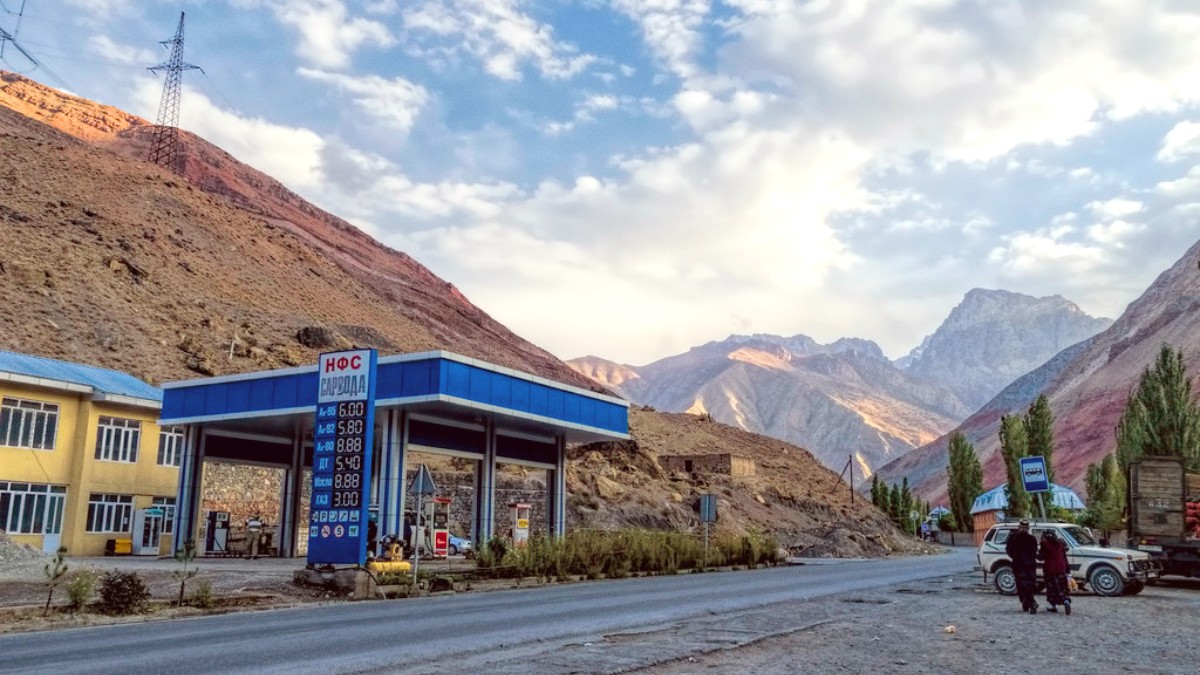
Tajikistan
Dushanbe sits nestled in the Gissar Valley, a fertile basin in the southwestern part of Tajikistan. The city finds itself at an elevation of approximately 800 meters (2,600 feet) above sea level, a different climate and topography compared to the towering peaks that define much of the country. Rivers like the Varzob (Dushanbinka) flow through its heart, contributing to the city's lush greenery and a natural backdrop for its parks and avenues. To the north and east, the majestic Gissar Range of the Pamir-Alay mountains rises dramatically, a stark and beautiful contrast to the urban setting. The city’s location a natural hub, relatively easy access to both the lower-lying agricultural regions and the challenging mountain passes further afield. This geographical position historically made Dushanbe a melting pot, drawing influences from diverse surrounding areas, and it continues to shape its identity as a welcoming urban center surrounded by remarkable natural landscapes. Its position in the valley means Dushanbe is warmer than the higher mountain regions, yet still receives cooling breezes from the surrounding peaks. This setup lends itself to pleasant outdoor activities for much of the year, a comfortable environment for both residents and visitors to enjoy the city's outdoor spaces.
Dushanbe's history a story of rapid transformation, moving from a small village to a bustling capital in under a century. The city's name, derived from the Tajik word for "Monday," points to its origins as a small market village that would host a popular Monday bazaar. At the beginning of the 20th century, Dushanbe was little more than a settlement. However, its trajectory changed dramatically with the establishment of the Tajik Autonomous Soviet Socialist Republic in 1924, and its subsequent designation as the capital of the Tajik Soviet Socialist Republic in 1929. The Soviet era brought immense development, with wide boulevards, public buildings, and large parks designed in a distinct Soviet modernist style. It was renamed Stalinabad for a period, a testament to the ideological shifts of the time, before reverting to Dushanbe.
After Tajikistan gained independence in 1991, Dushanbe experienced a challenging period, including the Tajik Civil War (1992-1997). Despite these difficulties, the city has steadily rebuilt and developed, a confident capital. Today, Dushanbe reflects this layered history: Soviet-era monuments stand proudly, grand new architectural projects assert the nation’s independence, and the enduring traditions of Tajik culture thrive in its markets and tea houses. The city embodies a resilience and an ongoing journey of identity, making it a compelling place for visitors to observe history in motion. It a living museum of its past, while constantly looking to its future, welcoming the world to experience its unique narrative.
Dushanbe greets visitors with an inviting atmosphere and a straightforward urban layout. Expect wide, tree-lined avenues, notably along Rudaki Avenue, the city's main artery. Parks are abundant, green spaces for relaxation and strolls. The city presents a mix of old and new: grand Soviet-era buildings stand alongside modern high-rises and traditional tea houses. Locals demonstrate genuine hospitality, often greeting visitors with warmth. You will discover a city that feels relaxed and manageable, despite its status as a capital.
Public transportation is affordable and an easy way to get around, though much of the central area is walkable. Food is hearty and flavorful, with a strong emphasis on meat, rice, and fresh produce available at bustling bazaars. Safety is generally not a concern, making Dushanbe a comfortable place to explore independently. It a calm introduction to Central Asia before any planned adventures into the country's more rugged landscapes.
Dushanbe operates at a slower, more deliberate pace than many Western capitals. Allow yourself to adjust to this rhythm. Enjoy long tea breaks, leisurely strolls in the parks, and unhurried conversations. This approach truly connects you with the city's character.
The local currency, the Somoni, is used for nearly all transactions.
English understanding varies, but Russian is widely spoken, and a few Tajik phrases will be greatly appreciated.
The city rewards those who take the time to observe, interact, and absorb its particular charm.
This impacts what you wear and when you visit.
This city is not about flashy tourist traps but about experiencing a genuine cultural exchange and appreciating the quiet rhythm of Tajik life.
The local currency, the Somoni, is used for nearly all transactions. English understanding varies, but Russian is widely spoken, and a few Tajik phrases will be greatly appreciated.
Overall, Dushanbe a welcoming and intriguing experience for exploration of Tajikistan. It a city that rewards those who take the time to observe, interact, and absorb its particular charm.
This city is not about flashy tourist traps but about experiencing a genuine cultural exchange and appreciating the quiet rhythm of Tajik life.
Dushanbe greets visitors with an inviting atmosphere and a straightforward urban layout.
It a city that rewards those who take the time to observe, interact, and absorb its particular charm.
Dushanbe greets visitors with an inviting atmosphere and a straightforward urban layout.
Parks are abundant, green spaces for relaxation and strolls.
The city reflects a layered history: Soviet-era monuments stand proudly, grand new architectural projects assert the nation’s independence, and the enduring traditions of Tajik culture thrive.
Dushanbe presents a mix of old and new: grand Soviet-era buildings stand alongside modern high-rises and traditional tea houses. Locals demonstrate genuine hospitality, often greeting visitors with warmth. You will discover a city that feels relaxed and manageable, despite its status as a capital.